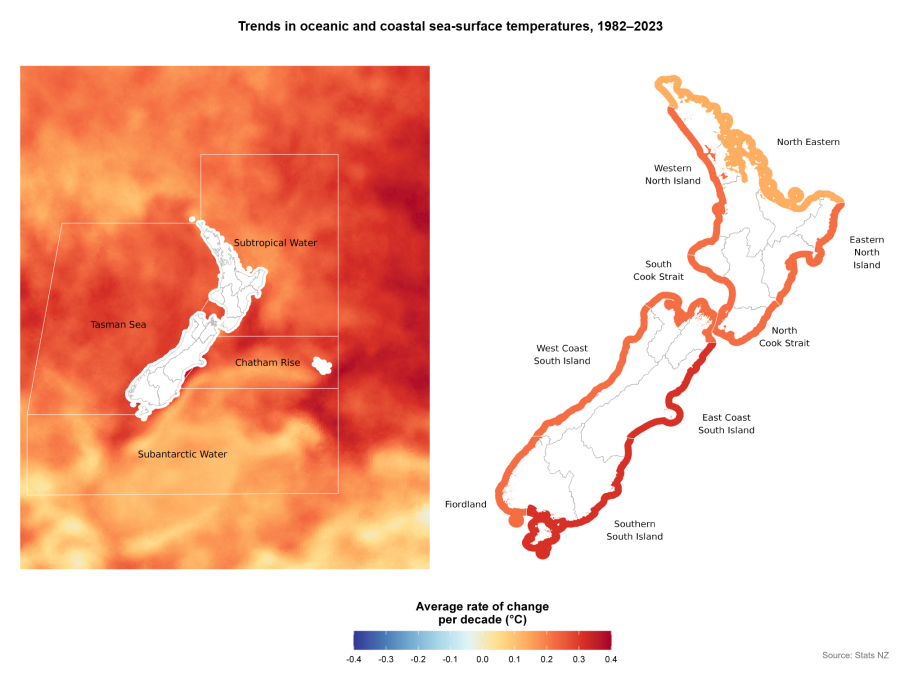Between 2022 and 2023, oceanic and coastal waters around Aotearoa New Zealand reached their warmest annual temperatures since the series began in 1982, according to data released by Stats NZ today.
"Measuring sea-surface temperature tells us how rapidly the ocean's uppermost productive layers are warming," environment and agricultural statistics senior manager Stuart Jones said.
Stats NZ has updated its Sea-surface temperature: Data to 2023 and Marine primary productivity: Data to 2023 environmental indicators, using data from the National Institute of Water and Atmospheric Research (NIWA).
Since 1982, sea-surface temperatures increased on average by between 0.16 to 0.26°C per decade (equivalent to 0.63 to 1.05°C during the recorded period) across oceanic regions, with the Tasman Sea having the highest average rate.
Coastal regions warmed on average by between 0.19 to 0.34°C per decade (equivalent to 0.74 to 1.35°C during the recorded period), with East Coast South Island having the highest average rate.
Each oceanic and coastal region experienced their hottest years ever recorded in either 2022 or 2023.
"Even small rises in temperature can disrupt marine ecosystems, cause some species to relocate, and increase disease risks," Jones said. "It also contributes to sea-level rise as the warmer water expands."

Text alternative for Trends in oceanic and coastal sea-surface temperatures, 1982-2023
The map on the left shows four oceanic regions of New Zealand: Subtropical Water, Tasman Sea, Chatham Rise, and Subantarctic Water. They are coloured to show the average rate of oceanic sea-surface temperature change per decade in degrees Celsius between 1982 and 2023. In the map on the right, the coastal areas around New Zealand are coloured to show the average rate of change. The scale for both maps ranges from a rate of change of -0.4 degrees Celsius (dark blue) to 0.4 degrees Celsius (red). Red represents positive rates of change meaning that the rate of sea-surface temperature is increasing, while at the other end of the scale dark blue represents negative rates of change meaning that the rate of sea-surface temperature is decreasing.
Marine heatwaves - prolonged periods of unusual seawater warmth - also reached new levels. The Tasman Sea spent 61 percent of the 2022 year in a marine heatwave, the highest among oceanic regions. Western North Island experienced heatwave conditions for 89 percent of the year, the highest among coastal regions.
Warming seas can influence primary production through the generation of organic matter by phytoplankton (microscopic algae), which supports the marine food chain. In the ocean surrounding New Zealand, between 1998 and 2022, marine primary productivity has tended to decrease with rising sea temperature in the warmer northern waters, while increasing with rising sea temperature in the cooler southern waters.
Stats NZ also published its River water quality - heavy metals: Data to 2022 indicator today, which reports on the concentrations of two dissolved metals in rivers and streams in predominately urban areas. Between 2013 and 2022, dissolved copper concentrations were increasing at 28 out of 50 sites, while dissolved zinc concentrations were decreasing at 36 out of 65 sites.
As part of a joint Environmental Reporting programme with partner Ministry for the Environment, Stats NZ publishes and updates environmental indicators on the pressures, state, and impacts of New Zealand's environment including air, marine, fresh water, land, and atmosphere and climate.






